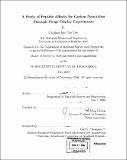A study of peptide affinity for carbon nanotubes through phage display experiments
Author(s)
Lau, Caroline Kar Yan, 1978-
DownloadFull printable version (1.742Mb)
Other Contributors
Massachusetts Institute of Technology. Dept. of Materials Science and Engineering.
Advisor
Yet-Ming Chiang.
Terms of use
Metadata
Show full item recordAbstract
The use of biological molecules to facilitate the dispersal, separation and assembly of nanoscopic entities such as carbon nanotubes has received great attention and has been the focus of much current research activity. In this work we sought to identify peptide sequences with selective affinity for HiPco-produced SWNTs in order to gain some insight to the binding mechanisms and interactions. This was done using a phage display technique, in which a library of bacteriophages displaying greater than 109 different 12-amino acid long peptide sequences were exposed to carbon nanotubes. Non-specifically bound phages were successively washed off with increasingly stronger detergents until only tightly binding phages remained. It was observed that after six rounds of phage display tests, the percentage of sites of aromatic ring-containing amino acids increased while the percentage of sites of aliphatic amino acids decreased. Results were compared to previous phage display results on MWNTs. These results suggest that peptides are able to distinguish between different allotropes of carbon and that their highly specific binding mechanisms can be exploited in the future for use in precision placement of nanoscale components in devices such as electronic circuits and sensors.
Description
Thesis (S.M.)--Massachusetts Institute of Technology, Dept. of Materials Science and Engineering, 2004. Includes bibliographical references (p. 55-60).
Date issued
2004Department
Massachusetts Institute of Technology. Department of Materials Science and EngineeringPublisher
Massachusetts Institute of Technology
Keywords
Materials Science and Engineering.